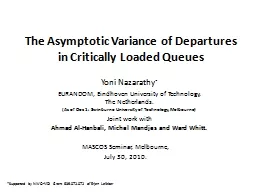

Yoni Nazarathy EURANDOM Eindhoven University of Technology The Netherlands As of Dec 1 Swinburne University of Technology Melbourne Joint work with Ahmad Al Hanbali Michel Mandjes ID: 797184
Download The PPT/PDF document "The Asymptotic Variance of Departures in..." is the property of its rightful owner. Permission is granted to download and print the materials on this web site for personal, non-commercial use only, and to display it on your personal computer provided you do not modify the materials and that you retain all copyright notices contained in the materials. By downloading content from our website, you accept the terms of this agreement.
Slide1
The Asymptotic Variance of Departures in Critically Loaded Queues
Yoni Nazarathy*EURANDOM, Eindhoven University of Technology,The Netherlands.(As of Dec 1: Swinburne University of Technology, Melbourne)Joint work with Ahmad Al-Hanbali, Michel Mandjes and Ward Whitt.
MASCOS Seminar, Melbourne, July 30, 2010.
*Supported by NWO-VIDI Grant 639.072.072 of Erjen Lefeber
Slide2OverviewGI/G/1 Queue with
number of served customers duringAsymptotic variance:Balancing Reduces Asymptotic Variance of OutputsMain Result:
Slide3The GI/G/1/K Queue
overflows
Load:
Squared coefficients of variation:
Assume:
Slide4Variance of Outputs
* Stationary
stable M/M/1, D(t) is
PoissonProcess
( ):
* Stationary
M/M/1/1
with ,
D(t) is
RenewalProcess
(
Erlang
(2, )):
* In general, for renewal process with
:
* The output process of most
queueing
systems is NOT renewal
Asymptotic Variance
Simple Examples:
Notes:
Slide5Asymptotic Variance for (simple)
After finite time, server busy forever… is approximately the same as when or
Slide6M/M/1/K: Reduction of Variance when
Slide7Summary of known BRAVO Results
Slide8Balancing R
educes Asymptotic Variance of OutputsTheorem (N. , Weiss 2008): For the M/M/1/K queue with :
Conjecture (N. 2009):For the GI/G/1/K queue with :
Theorem (Al
Hanbali
,
Mandjes
, N. , Whitt 2010):
For the GI/G/1 queue with , under some further technical conditions:
Focus of this talk
Slide9BRAVO Effect (illustration for M/M/1)
Slide10Assume GI/G/1 with and finite second moments
The remainder of the talks outlinesthe proof and conditions for:
Slide11Theorem 1: Assume that is UI,
then , with Theorem 2:
Theorem 3: Assume finite 4’th moments,then, Q is UI under the following cases:(i) Whenever and L(.) bounded (ii) M/G/1(iii) GI/NWU/1 (includes GI/M/1)
(iv) D/G/1 with services bounded away from 0
3 Steps for
Slide12Proof Outlinefor Theorems 1,2,3
Slide13D.L.
Iglehart and W. Whitt. Multiple Channel Queues in Heavy Traffic. I. Advances in Applied Probability, 2(1):150-177, 1970.Proof:
so also,
If,
then,
Theorem 1: Assume that is UI,
then , with
Slide14Theorem 1 (cont.)
We now show:
is UI since A(.) is renewal
is UI by assumption
Slide15Theorem 2
Theorem 2:
Proof Outline:
Brownian Bridge:
Slide16Theorem 2 (cont.)
Now use (e.g.
Mandjes 2007), Manipulate + use symmetry of Brownian bridge and uncondition….
Quadratic expression in u
Linear expression in u
Now compute the variance.
Slide17Theorem 3: Proving is UI for some cases
After some manipulation…
So Q’ is UI
Assume
Now some questions:
What is the relation between Q’(t) and Q(t)?
When does (*) hold?
(*)
Some answers:
Well known for GI/M/1: Q’(.) and Q(.) have the same distribution
For M/M/1 use
Doob’s
maximum inequality:
Lemma:
For renewal processes with finite fourth moment, (*) holds.
Ideas of proof: Find related martingale, relate it to a stopped martingale, then
Use Wald’s identity to look at the order of growth of the moments.
Slide18Going beyond the GI/M/1 queue
Proposition: (i) For the GI/NWU/1 case: (ii) For the general GI/G/1 case: C(t) counts the number of busy cycles up to time tQuestion: How fast does grow?
Lemma (Due to Andreas Lopker): For renewal process with
Zwart
2001: For M/G/1:
So, Q is UI under the following cases:
(
i
) Whenever and L(.) bounded
(ii) M/G/1
(iii) GI/NWU/1 (includes GI/M/1)
(iv) D/G/1 with services bounded away from 0
Slide19SummaryCritically loaded GI/G/1 Queue:
UI of in critical case is challengingMany open questions related to BRAVO,both technical and practical
Slide20References
Yoni Nazarathy and Gideon Weiss, The asymptotic variance rate of the output process of finite capacity birth-death queues. Queueing Systems, 59(2):135-156, 2008.Yoni Nazarathy, 2009, The variance of departure processes: Puzzling behavior and open problems. Preprint, EURANDOM Technical Report Series, 2009-045.
Ahmad Al-Hanbali, Michel Mandjes, Yoni Nazarathy
and
Ward Whitt. Preprint.
The asymptotic variance of departures in critically loaded queues.
Preprint, EURANDOM Technical Report Series, 2010-001.